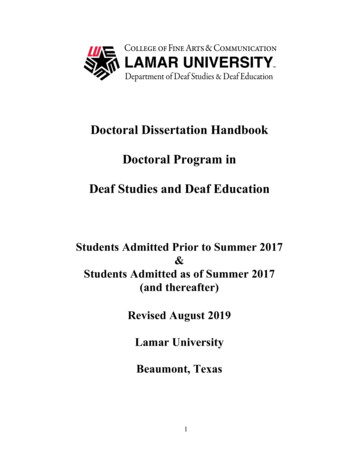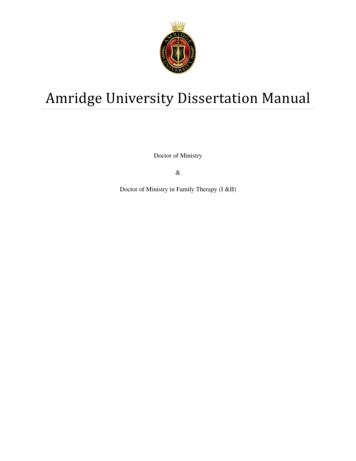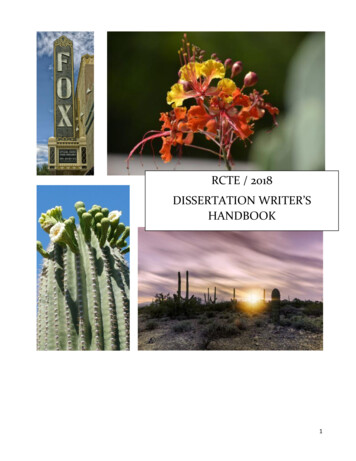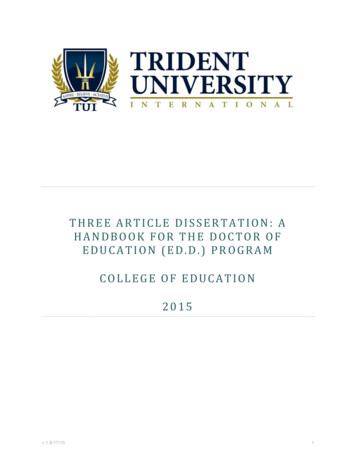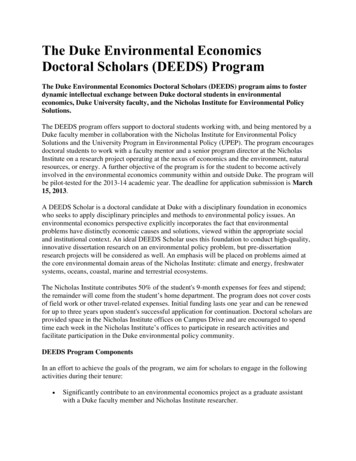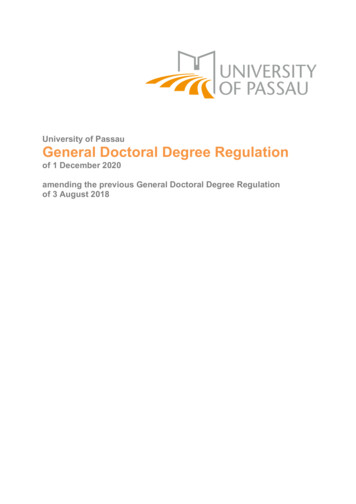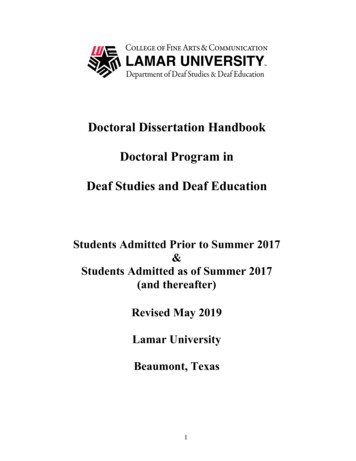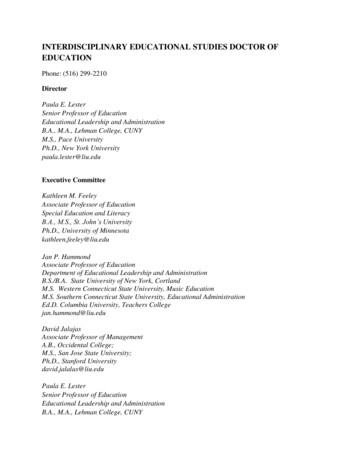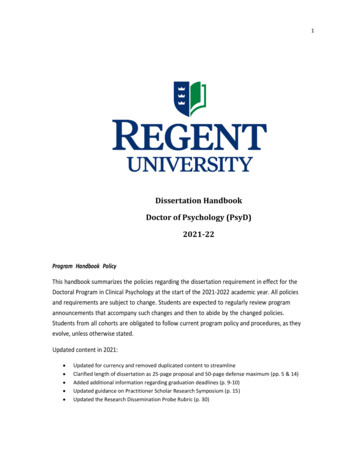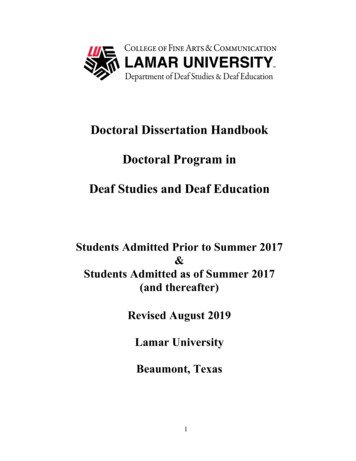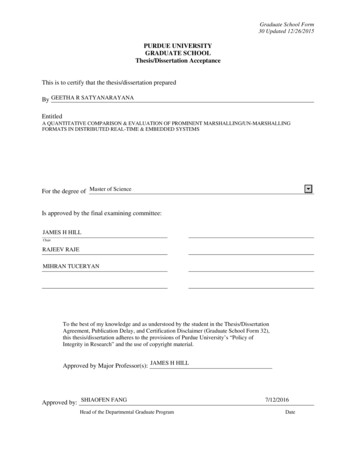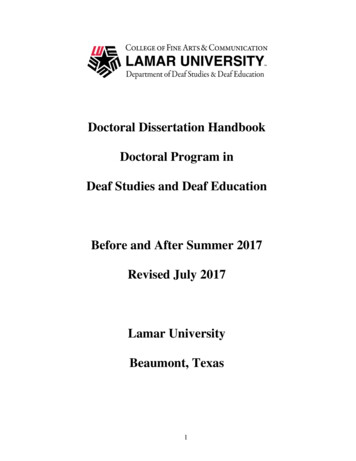
Transcription
Doctoral Dissertation HandbookDoctoral Program inDeaf Studies and Deaf EducationBefore and After Summer 2017Revised July 2017Lamar UniversityBeaumont, Texas1
Table of ContentsIntroduction . 4Progress Through the Doctoral Program . 4Acceptance . 4Program Learning Outcomes . 4Preliminary Examinations . 5Doctoral Candidate . 5Doctoral Academic Advisor . 6Dissertation Committee Chair . 6Comprehensive Examinations . 7Dissertation Committee . 8Dissertation Proposal Defense . 10Components of the Research Proposal and Dissertation . 11Parts of a Formal Research Proposal and Dissertation Research. 11Proposal/Dissertation . 12Moving Towards Dissertation Defense . 15Preliminary Submission to Graduate Editor . 15Preparation to Defend . 16Preparation to Graduate . 16Final Oral Examination . 16Final Submission Process . 17How to Submit Your Electronic Thesis or Dissertation (ETD) Online . 18Forms . 20D-0Preliminary Program Plan . 212
Listing of Ed. D. Deaf Studies and Deaf Education Courses – Before Summer 2017 . 22Deaf Studies and Deaf Education Course Sequence – Before Summer 2017 . 23Listing of Ed. D. Deaf Studies and Deaf Education Courses – As of Summer 2017 . 24Deaf Studies and Deaf Education Course Sequence – As of Summer 2017. 25Preliminary Program Plan: DSDE Doctoral (Ed.D) – As of Summer 2017 . 26D-1Preliminary Examination Committee . 28D-2Results of the Preliminary Examination. 29D-3A Course of Study . 30D-3B Composition of Doctoral Committee . 32D-4Approval of Dissertation Proposal . 33D-5A Schedule for Doctoral Dissertation Oral Defense. 34D-5B Results of the Dissertation Defense. 35D-6Transfer Credit . 36D-7Results of Comprehensive Written and/or Oral Examination . 37Assessment for the Doctoral Comprehensive Candidacy Portfolio Review . 40Rubric for Evaluating Doctoral Comprehensive Candidacy Concept Paper . 41D-15A Request to Change Graduate Student’s Committee . 433
IntroductionThe doctoral dissertation handbook, graduate catalog, and official university website provideinformation concerning policies and procedures for students in the Deaf Studies and DeafEducation doctoral program. The student is responsible for reading all literature on the DeafStudies and Deaf Education program, college, and university policies and procedures.The Deaf Studies and Deaf Education program was approved by the Texas Higher EducationCoordinating Board, as a 66-hour Doctor of Education (Ed. D.) in 1993. The 66-hour programcontains 30 hours of core courses, 21 hours of cognate courses, 9 hours statistic/research courses,and 6 hours of dissertation.Lamar University is one of only a few universities in the U.S. offering a doctoral degree in DeafStudies and Deaf Education. Lamar University is addressing a critical national and internationalshortage of doctoral-trained educators of the deaf. Graduates of the doctoral program takeleadership roles in schools for the deaf or become teacher trainers in university settings. Bothhearing and deaf applicants are accepted.General admissions requirements can be found in the graduate catalog and on the universitywebsite. After the student has been accepted by the College of Graduate Studies, and Departmentof Deaf Studies and Deaf Education, the student meets with the director of Deaf Education division(or designated representative). The director will assist the student and advise them for firstsemester courses and address the issue of who will be the faculty advisor. The director of DeafEducation will also provide an overview and answer any questions the student has at that time.Further, the director assists the student until an academic advisor is assigned. This assistance mayinclude, but is not limited, to course selection, research topics, procedural and policy requirements,and doctoral program requirements and deadlines. The academic advisor assists the student indeciding what courses are taken, what research topics are investigated, and in some cases, whattypes of financial support are available to the student. A student’s advisor, who must be a memberof the Deaf Studies and Deaf Education division faculty and must hold graduate faculty status atLamar University, will be chosen during the first year of residence.Progress Through the Doctoral ProgramAcceptanceDoctoral student enters program. Deaf Studies and Deaf Education divisional leader registershim/her for classes and assigns a “major” professor/academic advisor.Program Learning OutcomesDoctoral students’ progress through the doctoral program will include accomplishing four ProgramLearning Outcomes (PLOs). They include:1. Apply the basic principles of inquiry and research design to educational research2. Demonstrate “T” learning; the top of the T demonstrates breadth in knowledge about DeafStudies and Deaf Education while the stem of the T demonstrates depth of knowledge in thecognate/dissertation area4
3. Demonstrate ability of ASL/English bilingual fluency in academic content4. Publish peer-reviewed and translational articlesPreliminary ExaminationsThe preliminary examinations are designed to assess the student’s capacity for critical analysis andsynthesized integration of knowledge acquired during the course of study for the doctoral degree inDeaf Studies and Deaf Education. Satisfactory performance in coursework does not necessarilyguarantee successful performance on the preliminary examination. A student may take thisexamination after completion of 18 credits of doctoral-level course work within the program. This18-semester hour must include a minimum of 4 core classes from the Deaf Studies and DeafEducation program. Approval of the degree plan (Form D-0: Preliminary Program Plan) from thedoctoral program director is required prior to establishing the dates for the exam. The DoctoralProgram Director will create the committee.The preliminary examinations occur typically in the summer after beginning the program. Studentswill be given a question by the Doctoral Program Director and have two weeks to complete thewritten paper. The paper can be no more than 15 pages (fewer pages may not be enough toeffectively answer the question), must be typed with 12-point font and include 1-inch margins allaround. Students may not collaborate while taking their preliminary examination.If a student fails the preliminary examination, it can be repeated one time, but must be retakenwithin one month of the original exam. Once the preliminary examinations are passed, the studentis admitted to candidacy on recommendation of the Doctoral Advisory Committee.Reasonable accommodations will be made to allow students with disabilities to take the preliminaryexamination. The student should discuss individual needs with the chair of the doctoral advisorycommittee to arrange needed accommodations.Doctoral CandidateA doctoral candidate is a student, in good standing enrolled in a doctoral program, who hascompleted required examinations successfully and has been deemed ready by the program to start adissertation study. The dissertation is the last requirement for the doctoral degree.Doctoral candidates take responsibility to seek the cooperation of appropriate, qualified individualsto serve on his or her dissertation committee and to initiate dialogue with committee members,follow recommended timetables, and plan committee meetings in accordance with therecommendations of the committee chair. In working relationships with committee members, thecandidate should be mindful that members have many other professional responsibilities.The successful completion of a dissertation is emphasized is only one of the requirements; however,it is a necessary step for earning a doctoral degree. It is the student’s responsibility to understandand satisfy all of the requirements of the individual program and of the university. Doctoralcandidates must maintain matriculation at the university until completion of the degree. Dependingon the program requirements and the student’s individual circumstances, the enrollment status maybe full- or part-time. Even when a student has completed all other requirements of the program withthe exception of the dissertation, he or she must continue to register each semester until completion.5
Doctoral Academic AdvisorDuties of Doctoral Academic Advisor. As stated above, the director of the Deaf Studiesand Deaf Education division assigns the doctoral student with an Academic Advisor. This advisorwill assist the doctoral student until the student has passed the preliminary examination. Afterpassing the preliminary examination, the Doctoral Committee is formed. The Academic Advisormay later be chosen as the Dissertation Committee Chair but it is not a requirement. TheDissertation Committee Chair and the student will work closely, especially when doing researchand writing the dissertation. Choosing the Dissertation Chair is one of the most important decisionsthat a doctoral student makes. Besides the research and dissertation work, the DissertationCommittee Chair may be instrumental in helping a student obtain a job after graduation.How to Change the Doctoral Academic Advisor. During the doctoral student’s course ofstudy, the student may choose to change an Academic Advisor for a variety of reasons. The studentmay develop an intellectual rapport with another faculty member with research interests that thestudent would like to explore. The student may want to change his or her research topic. Inextreme cases, a personality conflict may arise that leads either the faculty member or student tobelieve that a working relationship would not be possible. In the event the student wishes to changean Academic Advisor, he or she must meet with a Senior Doctoral Advisor or the Department Chairto seek approval prior to changing an Academic Advisor.Dissertation Committee ChairDuties. The Dissertation Committee Chair is the doctoral candidate’s primary advisorduring all phases of the dissertation process. The Dissertation Committee Chair is the leader of theDissertation Committee and its liaison with the student, the program, the Department of DeafStudies and Deaf Education, and the Graduate School (Please note that the Dissertation CommitteeChair may or may not be the same individual as the candidate’s Doctoral Chair). The DissertationCommittee Chair convenes and conducts the proposal and dissertation defense meetings. Inconjunction with other Dissertation Committee members, the Dissertation Committee Chair isresponsible for providing technical and content advice and assistance. A faculty member, who hasserved on at least three Dissertation Committees at any accredited college or university, is eligibleto chair a Dissertation Committee. Exceptions may be granted by the Dean of the Graduate Studiesif officially requested and justified by the Chair of the Department of Deaf Studies and DeafEducation. Unless an exception is recommended by the Chair of the Department of Deaf Studiesand Deaf Education and approved by the Graduate Dean, the Chair should be a member of theDepartment of Deaf Studies and Deaf Education in which the degree program is offered. However,otherwise qualified individuals outside the Department of Deaf Studies and Deaf Education mayserve in a Dissertation Committee Co-Chair capacity if the Chair of the Department of Deaf Studiesand Deaf Education approves such an arrangement. Dissertation Committee Chairs who terminateemployment with Lamar University may continue committee service for a 12-month periodfollowing the termination. After that time, the individual may no longer serve as DoctoralDissertation Committee Chair, but may serve as Dissertation Committee Co-Chair (with theDepartment of Deaf Studies and Deaf Education Chair’s approval) or simply as a member of thecommittee.6
Choosing the Dissertation Committee Chair. Choosing the Dissertation Committee Chairis a process that is two-way. The student may choose the Professor as a Dissertation CommitteeChair, but the Professor must also agree to assume the responsibility for the student. Doctoralstudents are encouraged to get to know faculty members, seek copies of their vita, and theirresearch and publication record, and begin to establish a relationship with a Professor with whomthey have mutual research interests and with whom they feel comfortable communicating andinteracting. Students can begin to get to know faculty members by taking course with them orthrough scheduled appointments to discuss mutual research interests.In some cases, the Academic Advisor and the Program Director of Deaf Studies and DeafEducation may feel it is in the best interest of the student to work with a specific faculty memberbecause of the faculty member’s area of research expertise and publication record. But, a studentmay not feel comfortable with this agreement. Students are allowed to select the DissertationCommittee Chair of their choice. But, they are encouraged to seek the advice and counsel of theirAdvisor and the Program Director of Deaf Studies and Deaf Education to find a DissertationCommittee Chair who can best assist them in growing intellectually in their field.There are many reasons a Professor may decide not to work with a student. The Professor may beadvising too many students to provide quality time with them. The Professor may also feel that heor she would not work well with the student. By choosing the Dissertation Committee Chair, bothstudent and faculty must realize that each party should choose each other. Students may decide tochoose a faculty member to be their Dissertation Committee Chair for a variety of reasons such asthe faculty member’s reputation for quality teaching, scholarship, research productivity,publications, student advocacy, and interpersonal style.The student and the Dissertation Committee Chair should know about each other before choosing towork together. It is a relationship built on mutual respect for each other. As mentioned above, thestudent should know the research interests, publication productivity record, and the expectations ofthe dissertation chair. The Professor should know the student’s background experience, workhabits and research interests. Both should be comfortable communicating and working with eachother. Once the Dissertation Committee Chair is selected, Form D-3B is developed. TheDissertation Committee Chair will assist the student in selecting other members of the DissertationCommittee, finalize the courses of study, and complete the dissertation.Comprehensive ExaminationsThe Deaf Studies and Deaf Education doctoral comprehensive examination format will utilize aportfolio approach that requires students to document and demonstrate their knowledge and skills inDeaf Studies and Deaf Education, research, teaching, and leadership attained from coursework andtheir academic experiences during the course of their doctoral studies. Portfolios will be evaluatedto determine if students have the ability to evaluate, synthesize, and apply the knowledge obtainedin their studies. Therefore, students will provide evidence of accomplishing Program LearningOutcomes (PLOs). Additionally, the concept paper determines if the student has the ability toconduct independent research prior to beginning the dissertation.Developing a Portfolio. In order to pass the comprehensive examination, students mustprovide evidence required to demonstrate that they have developed the skills to do independentresearch. The portfolio must include:7
1.2.3.4.Professional goal statement;Curriculum vitae;Official program of study;Evidence of scholarly productivity through course work (literature review, synthesis paper,publication, translational piece);5. Reflections on the impact of their coursework and time in the program on their professionaldevelopment; and6. Concept Paper.Writing a Research Concept Paper. Students must develop a research concept paper. Theirpaper should not be longer than 15 pages, but double spaced, using 12-point font, and 1-inchmargins. The paper itself should show that the student is able to develop a research proposal.The content of the research concept paper is a “mini” dissertation proposal. The research conceptpaper should be ready to jump into the dissertation proposal after students pass their comprehensiveexamination. The research concept paper itself should include a literature review that highlights theproblem with students’ own theoretical argument or framework.For example, Deaf students must have auditory phonology to become successful readers. Youshould present the counterargument based on literature so that you can establish your claim. Aclaim becomes the basis for your research question (qualitative design) or hypothesis (quantitativedesign). In the above example, the claim was that “auditory phonology is not necessary to becomea skilled Deaf reader”. Then, you complete the research concept paper with your methodology. Theclaim above requires a quantitative design using a non-verbal phonology measure to determine ifyou can identify highly skilled Deaf readers without auditory phonology. You should work closelywith your Dissertation Committee Chair on the creation of your research concept paper. Youshould write your research concept paper in the Proposal Writing class in conjunction with yourDissertation Committee Chair.Review of Portfolio Documents:The comprehensive exam committee will evaluate the portfolio document. The ComprehensiveCandidacy Portfolio Rubric will be completed by each member of the committee and collated bythe Department of Deaf Studies and Deaf Education Program Director of Doctoral Program. If therubric determines that the candidate has achieved a “pass”, the student will move forward withProposal Writing and their Dissertation.If a student fails, the student will be given a one-time second opportunity to re-submit the portfolio,to be completed within one month of the first attempt. If the student fails during the secondattempt, the student will be terminated from the doctoral program.Dissertation CommitteeWorking together, the student and Dissertation Committee Chair will decide on the DissertationCommittee. A Dissertation Committee consists of a minimum of five graduate faculty member,including a minimum of three Lamar University Deaf Studies and Deaf Education faculty members,and two other graduate faculty members. Two other graduate faculty members must either bemembers of the Lamar University graduate faculty or outside the university. They should be chosen8
for his/her expertise in research design or content area. As is the case with choosing theDissertation Committee, all members must agree to be on the committee.The Dissertation Committee becomes official with the submission of the Form D-3B (Compositionof Doctoral Committee Form) to the Graduate Studies office. As this Form must also be sign by theDepartment of Deaf Studies and Deaf Education Chair and by the Dean of the Graduate School,these two persons, in effect, approve the Dissertation Committee.The Dissertation Committee: approves the components of the comprehensive examinations; has the final decision regarding pass/fail of the comprehensive examinations; approves the dissertation proposal; works with the student and dissertation chair in advising, encouraging, and approving thedissertation research; attends the proposal presentation; approves the scheduling of the final oral examination; has the final decision regarding pass/fail of the oral dissertation defense; and has the final decision regarding the acceptance of the dissertation.Note:The Academic Advisor will be instrumental in setting up the committee for the preliminary exam.The Dissertation Committee, however, is responsible for the comprehensive exam, dissertationproposal, and the dissertation defense, and will be set up by the Dissertation Committee Chair andthe student. It should be noted that some of the activities included in the above list must also havethe approval of the Department of Deaf Studies and Deaf Education Chair and the Graduate Dean.Because these activities are important steps in earning a doctoral degree, students should take carein choosing Dissertation Committee members and be certain that the members have interest,expertise, and publications in areas related to the planned research.Duties of Dissertation Committee Chair and Committee Members. Most of the activitiesin the above list are relatively common for doctoral programs. However, given the interdisciplinarynature of Deaf Studies and Deaf Education, it may be that the Dissertation Committee will need tobe more active in ‘promotion and approving the research’ than might be the case in a doctoralprogram in a discipline with relatively less interface with other disciplines. Further, it is the casethat the proposed research includes sub-areas atypical for Deaf Studies and Deaf Education, it isimportant to choose Dissertation Committee members with expertise, interest, and publications inthose sub-areas.How to Change the Dissertation Committee Chair. Under certain circumstances, thedoctoral student may change his/her Dissertation Committee Chair. Situations such as, but notlimited to, interpersonal conflict, lack of appropriate and timely assistance from the DissertationCommittee Chair, or a change of dissertation topic may necessitate the changing of the DissertationCommittee Chair. To change a Dissertation Committee Chair, it is recommended, though notmandated, that the student first share their concerns with his/her Dissertation Committee Chair. Inextreme circumstances the student may not feel comfortable meeting with their DissertationCommittee Chair due to serious breakdowns in communication. If the doctoral student still wantsto change their Dissertation Committee Chair and are still not comfortable communicating with theDissertation Committee Chair, they next step is to meet with the Chair of the Department of DeafStudies and Deaf Education and share the reasons why a change is necessary.9
If the problem still remains, the Department of Deaf Studies and Deaf Education Chair will assistthe doctoral student with the selection of a new chair. Once a new Dissertation Committee Chairhas been recommended and accepted, Form D-15A (Request to Change Graduate Student’sCommittee Form) should be filled out and signed by the new Dissertation Committee Chair, theDepartment of Deaf Studies and Deaf Education Chair, and the Dean of Graduate Studies.Students may not be allowed to continue working on a previously defined research topic if theformer Dissertation Committee Chair has published in the topic area and has contributed time andwork on the student’s project. The Department of Deaf Studies and Deaf Education Chair willdecide whether or not the topic remains the same or if the student needs to define a new topic withthe new Dissertation Committee Chair.Dissertation Proposal DefenseAfter passing comprehensive examination, the candidate begins to work with the DissertationCommittee Chair to transform the research concept paper into the dissertation proposal. Thecandidate and the Dissertation Committee Chair must work closely together to prepare the proposal.The Chair of the Dissertation Committee after giving approval that the dissertation proposal isready to be defended, submits the proposal to all members of the Dissertation Committee. TheDissertation Committee has two weeks to review and provide feedback to the candidate. Afterreceiving feedback, the candidate should make the requested changes and again obtain theagreement of the Dissertation Committee Chair that the proposal is ready to defend. The candidatewill then contact all Dissertation Committee members and schedule the defense. The candidateshould work with the Deaf Studies and Deaf Education Administrative Assistant to schedule a roomfor the defense as well as any required interpreters.If the proposal is found to be acceptable during a defense, “Approval of Dissertation Proposal”(Form D-4) is signed by all Dissertation Committee members. The Dissertation Committee Chairshould retain this form while the proposal is then submitted by the student to the InstitutionalReview Board (IRB) for review. Both Dissertation Committee approval and IRB approval arerequired before work can proceed. A copy of the approved proposal and the approved IRB formmust be attached to the original copy (with original signatures) of Form D-4, which the DoctoralProgram Director then submits to the Graduate Dean’s office for review and filing. A copy of theapproved dissertation proposal and a photocopy of the IRB’s approval should be given to theDoctoral Program Director for the student’s file in the office of the Department of Deaf Studies andDeaf Education.10
Components of the Research Proposal and DissertationNote:See Lamar University’s Graduate Studies Guidelines for Preparing Theses and Dissertations es/index.htmlThe dissertation document should follow in sequence the steps of the research process. In general,dissertations at Lamar University should comply with the stylistic guidelines traditionally used forcreating documents by members of the academic field of the department. For most departments atLamar University, that means abiding by the writing style described in the most recent edition ofthe Publication Manual of the American Psychological Association, henceforth referred to in thishandbook as the APA Manual. Many of the style guides are “copy” style requirements, includingfeatures appropriate for journal article submissions but not for “final” style documents such asdissertations. For example, copy style typically suggests that figures and tables appear on separatepages at the end of the document with instructions to place the figure or table “about here” in thetext.In a dissertation, these elements should be incorporated by the student into the appropriate locationin the document. Similarly, running heads, appropriate for journal copy, are inappropriate indissertations. Please find examples of dissertations in your departmental collection or in the LamarUniversity Library to see how page layout is typically handled in bound dissertations at LamarUniversity. There may be individual situations in which, based on the content of the dissertation,the committee will recommend that a style guide other than APA be used. In these instances, thecommittee chair should consult with the graduate dean prior to recommending the alternative styleguide.It should be noted
Doctoral Program in Deaf Studies and Deaf Education Before and After Summer 2017 Revised July 2017 Lamar University Beaumont, Texas . 2 Table of Contents . The doctoral dissertation handbook, graduate catalog, and official university website provide
